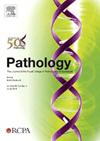Re-evaluation of the concept of basaloid follicular hamartoma associated with naevoid basal cell carcinoma syndrome: a morphological, immunohistochemical and molecular study
IF 3.6
3区 医学
Q1 PATHOLOGY
引用次数: 0
Abstract
Naevoid basal cell carcinoma syndrome (NBCCS) is a rare genodermatosis caused by germline mutations in genes of the Sonic Hedgehog (SHH) pathway and is characterised by early onset of multiple basal cell carcinomas (BCCs). Although skin tumours with follicular differentiation, notably basaloid follicular hamartoma (BFH), have been reported in NBCCS, their relations with BCC are poorly defined. In this context, the aim of this study was to clarify morphological, immunohistochemical and molecular features of BFH arising in a context of NBCCS. A total of 140 skin tumours from NBCCS and 140 control BCC tumours were reviewed, blinded to clinical data and classified as BCC or BFH. The morphological characteristics of these two groups were then compared. Twenty cases were submitted for immunohistochemical and molecular analysis. Thirty-three tumours among the exploratory cohort were classified as BFH and were exclusively detected in NBCCS patients. Histopathological criteria that were significantly different from BCC were as follows: a small size (<1.5 mm), connection to a hair follicle, arborescent organoid architecture, lack of cytological atypia and infundibulocystic differentiation. Immunohistochemical analysis confirmed activation of the SHH pathway in these lesions. Targeted next-generation sequencing suggested that MYCN and GLI2/3 amplifications and TP53 mutations might be involved in progression of these follicular tumours to BCC. Our study confirms the high prevalence of BFH, representing up to 24% of skin tumours in NBCCS and potentially being BCC precursors.
重新评估基底样滤泡火腿瘤与无色素性基底细胞癌综合征相关的概念:形态学、免疫组化和分子研究。
无毛囊基底细胞癌综合征(NBCCS)是一种罕见的遗传性皮肤病,由音速刺猬(SHH)通路基因的种系突变引起,其特征是早发性多发性基底细胞癌(BCC)。虽然有报道称 NBCCS 患者会出现毛囊分化的皮肤肿瘤,特别是基底样毛囊火腿瘤(BFH),但它们与 BCC 的关系还不十分明确。在这种情况下,本研究旨在明确在 NBCCS 中出现的 BFH 的形态学、免疫组化和分子特征。研究人员对来自 NBCCS 的 140 例皮肤肿瘤和 BCC 对照组的 140 例肿瘤进行了复查,对临床数据进行了盲法处理,并将其分类为 BCC 或 BFH。然后比较两组肿瘤的形态特征。20 个病例被提交进行免疫组化和分子分析。在探索性组群中,有 33 例肿瘤被归类为 BFH,并且只在 NBCCS 患者中发现。与 BCC 有明显差异的组织病理学标准如下:体积小 (
本文章由计算机程序翻译,如有差异,请以英文原文为准。
求助全文
约1分钟内获得全文
求助全文
来源期刊

Pathology
医学-病理学
CiteScore
6.50
自引率
2.20%
发文量
459
审稿时长
54 days
期刊介绍:
Published by Elsevier from 2016
Pathology is the official journal of the Royal College of Pathologists of Australasia (RCPA). It is committed to publishing peer-reviewed, original articles related to the science of pathology in its broadest sense, including anatomical pathology, chemical pathology and biochemistry, cytopathology, experimental pathology, forensic pathology and morbid anatomy, genetics, haematology, immunology and immunopathology, microbiology and molecular pathology.
 求助内容:
求助内容: 应助结果提醒方式:
应助结果提醒方式:


